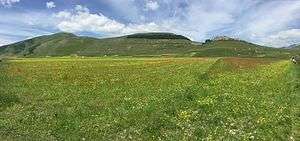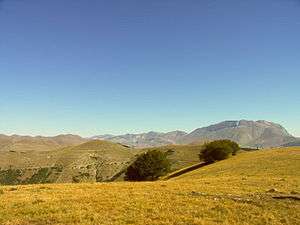Sibillini Mountains


The Sibillini Mountains, or Sibylline Mountains (Italian: Monti Sibillini) are a mountain group in Italy, part of the central Apennines. Situated between eastern Umbria and the Marche, they are mostly composed of limestone rocks, formed in the Mesozoic and Cenozoic (100 to 50 million years ago) on the bottom of an extinct sea. The land emerged 20 million years ago. Most of the peaks are over 2,000 m (6,600 ft); the highest altitude is reached by Monte Vettore at 2,476 m (8,123 ft).
Since 1993 the area has been part of the Parco Nazionale dei Monti Sibillini (Sibillini Mountains National Park).
The current morphology, largely dominated by U-shaped valleys and glacial depressions, is due to the action of glaciers in the Quaternary period. Also regions of Karst topography are in evidence, caused by extension of the crust beneath western Italy and the Tyrrhenian Sea.
Legend says that a cave of the Sibyl (women,) housed a male prophet who rarely revealed secrets of the future. Necromancers and knights, came from across Europe, after exhausting journeys trying to seize an oracle of Sybil.
Wildlife and vegetation
The small Lago di Pilato within a deep u-shaped valley below Monte Vettore, is home to a crustacean endemic of this location, the Chirocephalus marchesonii.
The area contains stands of beech scattered amongst open subalpine grasslands and meadows maintained by the grazing of sheep.
See also
Sources
- Gentili, Bernardino (April 2002). "Note di Geomorfologia del Parco Nazionale dei Monti Sibillini". Collana dei Quaderni scientifico-divulgativi del Parco Nazionale dei Monti Sibillini. Ancona: Aniballi Grafiche.
Coordinates: 42°49′26″N 13°16′32″E / 42.82389°N 13.27556°E